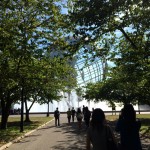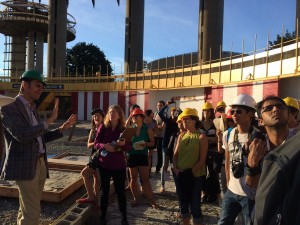A major highlight of the AAP NYC program is taking neighborhood tours of interesting developments around the city. Recently, we joined forces with Professor Jennifer Minner’s Land Use course from the Ithaca campus to tour Flushing Meadows-Corona Park in Queens.

Queens is the most racially and ethnically diverse county in the country, and nowhere is this diversity more apparent than in Flushing. The park, currently home to the USTA’s Arthur Ashe Stadium for the annual US Open as well as New York Mets’ Citi Field, expands well beyond these two sites. Originally developed from an old ash dump into an 897-acre park on the 25th and 75th anniversaries of the 1939 and the 1964 World’s Fair, respectively, the park grounds became a showcase for innovation from New York State. Today, the site sits largely vacant, stitched together within the fabric of the park itself.
First, we met with Janice Melnick and John Krawchuk from NYC Parks, who were gracious enough to give us a breakdown of the park’s usage and operations, as well as historic development. As the 4th largest open space in New York City, Corona Park boasts a $20 million capital budget. Unlike Central Park, however, it is used largely as a “working park” today and is popularly known as the “utilitarian” or “community-based” park of the City with seven million visitors a year. As any parks planner will tell you, maintenance, operations and programming are often just as or more important than the physical design and layout of the park. Flushing Meadows-Corona Park boasts heavy usage, ranging from Ecuadorian Volleyball and cricket tournaments to ethnic festivals such as Cinco de Mayo and the Hong Kong Dragon Boat Race Day, as well as everyday family functions and weddings.
In addition to the open spaces and stadiums, the park also boasts:
- The Unisphere, the world’s largest representation of planet Earth and the largest fountain at the time of construction. Made of more than 700,000 pounds of stainless steel, the fountain/sculpture stands today a symbol of Queens’ diversity.
- The Queens Museum, which houses the largest accurate 3-D model of New York City in the world. Check it out!

- A beautifully restored, handmade carousal – definitely a blast to the past! Modeled after the Coney Island carousals, this gem features over 70 hand painted horses!
- Two rising towers from the World’s Fair – you might remember them as the floating spaceships from Men in Black. What you probably didn’t see, however, is the historic gem behind the towers: The New York State Pavilion. Although it was originally developed as an engineering marvel to be showcased at the World’s Fair, the Pavilion has since changed ownership multiple times and has been the subject of a large historic preservation effort. At the Queens museum, we even got to view a screening of a recently produced documentary on the historical legacy of the structure. You can view the trailer here.

Home to many recycled uses (including a roller rink!), the N.Y.S. Pavilion has been restored largely through volunteer efforts but sits vacant today
Interestingly enough, the concepts for modern theme and amusement parks came out of World’s Fairs. Do you think they should be preserved? Why or why not? What do you imagine Corona Park to be in 10 years? Sound off in the comments!
